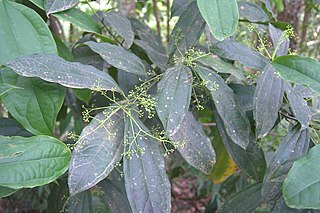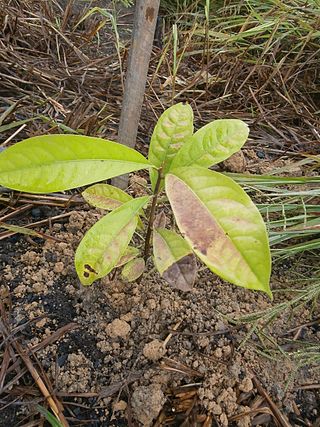
Central America is a subregion of North America. Its political boundaries are defined as bordering Mexico to the north, Colombia to the southeast, the Caribbean to the east, and the Pacific Ocean to the southwest. Central America is usually defined as consisting of seven countries: Belize, Costa Rica, El Salvador, Guatemala, Honduras, Nicaragua, and Panama. Within Central America is the Mesoamerican biodiversity hotspot, which extends from southern Mexico to southeastern Panama. Due to the presence of several active geologic faults and the Central America Volcanic Arc, there is a high amount of seismic activity in the region, such as volcanic eruptions and earthquakes, which has resulted in death, injury, and property damage.
The Inter-American Division of Seventh-day Adventists is a sub-entity of the General Conference of Seventh-day Adventists, which oversees the Church's work in Mexico, Central America, the Caribbean, and Northern South America.

Persea is a genus of about 150 species of evergreen trees belonging to the laurel family, Lauraceae. The best-known member of the genus is the avocado, P. americana, widely cultivated in subtropical regions for its large, edible fruit.

Pouteria is a genus of flowering trees in the gutta-percha family, Sapotaceae. The genus is widespread throughout the tropical Americas, with outlier species in Cameroon and Malesia. It includes the canistel, the mamey sapote, and the lucuma. Commonly, this genus is known as pouteria trees, or in some cases, eggfruits.

Pitcairnia is a genus of plants in the family Bromeliaceae, subfamily Pitcairnioideae. It was named for William Pitcairn, Scottish physician and gardener (1711–1791). The genus Pitcairnia ranks as the second most prolific of the bromeliad family. They are most abundant in Colombia, Peru and Brazil, but can also be found in areas from Cuba and Mexico south to Argentina. One species, Pitcairnia feliciana, is found in tropical West Africa and is the only member of the family Bromeliaceae not native to the Americas.

Cryosophila is a genus of medium-sized fan palms that range from central Mexico to northern Colombia. Species in the genus can be readily distinguished from related genera by their distinctive downward-pointing spines on the stem, which are actually modified roots. They are known as the "root spine palms".

Aegiphila is a genus of flowering plants in the mint family, Lamiaceae, first described in 1763. It was formerly classified in the Verbenaceae. It is native to Mexico, Central America, South America, the West Indies, and Florida.

Aiouea is a genus of shrubs and trees in the family Lauraceae. It is native to tropical forests and montane forests of North and South America. The name is a curiosity because it consists entirely of vowels.

Aniba is an American neotropical flowering plant genus in the family Lauraceae. They are present in low and mountain cloud forest in Caribbean islands, Central America, and northern to central South America.

Beilschmiedia is a genus of trees and shrubs in family Lauraceae. Most of its species grow in tropical climates, but a few of them are native to temperate regions, and they are widespread in tropical Asia, Africa, Madagascar, Australia, New Zealand, North America, Central America, the Caribbean, and South America. The best-known species to gardeners in temperate areas are B. berteroana and B. miersii because of their frost tolerance. Seeds of B. bancroftii were used as a source of food by Australian Aborigines. Timbers of some species are very valuable.

Gonolobus is a genus of plant in family Apocynaceae, first described in 1803. It is native to South America, Central America, Mexico, the West Indies, and the southern United States.

Licaria is a flowering plant genus in the family Lauraceae, native to Central America and South America. It is a Neotropical genus with around 80 species.

Nectandra is a genus of plant in the family Lauraceae. They are primarily Neotropical, with Nectandra coriacea being the only species reaching the southernmost United States. They have fruit with various medical effects. Sweetwood is a common name for some plants in this genus.
Damburneya cufodontisii is a species of plant in the family Lauraceae. It is found in Costa Rica, Nicaragua, and Panama.

Parmentiera is a genus of plants in the family Bignoniaceae.
Pleurothyrium is a genus of flowering plants in the family Lauraceae. It includes 48 species, which are native to Central America and northern South America. Many of the species were first described in a 1993 revision of the genus.
The Central America bioregion is a biogeographic region comprising southern Mexico and Central America.
Rhodostemonodaphne is a genus of flowering plants in the family Lauraceae. It is a neotropical genus consisting of approximately 41 species occurring in Central America and northern South America. This genus has many species that are valued for timber. The classification of the genus is unclear since the species in the genus fall into a well-supported but unresolved clade that also includes species with unisexual flowers currently placed in the genera Endlicheria and part of Ocotea.













